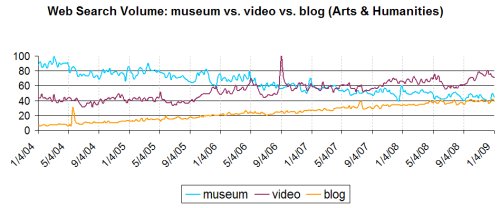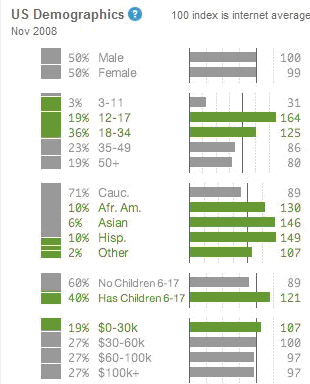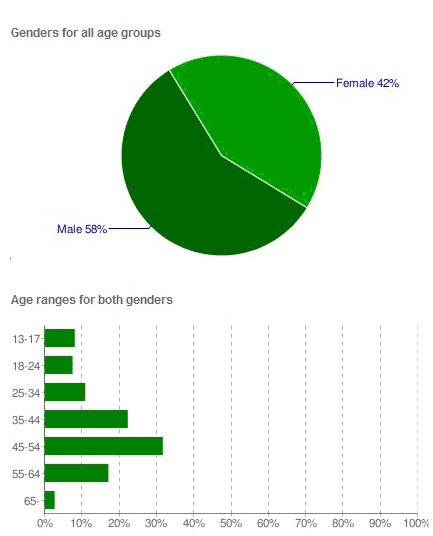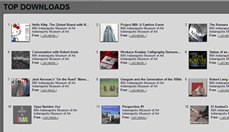The Expanding Role of On-line Video
In the past several years, the world has witnessed a dramatic expansion in the use of video as a vital communication medium on-line. Spanning on-line, embedded and user generated video content to video delivered via cell phones and inserted in chat sessions, the pervasive use of video is now a fact of life. On-line video Web sites such as YouTube and others have taken their place as fixtures in the on-line landscape. Consider that in November 2008, comScore Inc. reported that YouTube placed second only to Google in the number of search queries served (comScore, 2008), making it not only a major player in on-line video, but also the second largest search engine with respect to volume of searches regardless of content type. Likewise, the Pew Internet Project revealed in 2007 that nearly three-quarters (74%) of broadband users report watching or downloading on-line video content (Madden, 2008). Pew also reported in early 2008 that the audience of daily users of on-line video had increased dramatically from 8% to 15% between December 2006 and December 2007 (Rainie, 2008). More recently, comScore additionally reported that Americans watched 34% more on-line video in November 2008 as compared to just one year earlier (comScore, 2009). Clearly the trend regarding public access to and consumption of on-line video is expanding exponentially.
This fact has not been lost on museums and cultural institutions. The past several years have also shown a dramatic expansion in the number of museums and cultural institutions using on-line video as a way to engage audiences with their content and collections. Many museums are now actively using a variety of these distribution channels to promote their content. Alexander et al (Alexander, 2008) provided a survey of several museums using YouTube for distributing video. Greenfield provides insight for the use of collaborative and user-generated content platforms in his 2008 paper (Greenfield, 2008). Bernstein expanded upon the earlier Caruth, Bernstein paper (Caruth, 2007), highlighting the Brooklyn Museum’s community building efforts, including those using on-line video (Bernstein, 2008). Ways for museums to take advantage of these new media outlets were presented and discussed in detail by Incandela et al 2007 (Incandela, 2007) and Dance and Pau in 2007 (Dance, 2007).
For another interesting take on the role of video in promoting museum content, Figure 1 shows search volume data retrieved from Google’s Insight for Search (Google, 2009), a tool designed to reveal trends in search activity. The following graph shows the trends in searches containing the terms museum, video and blog within the Arts and Humanities category as defined by Google. While this graph shouldn’t be used to intimate absolute numbers, the trends here show that searches for video and blog are trending upward at roughly the same rate since 2004, while museum searches are steadily declining, with searches for video in this category overtaking searches for museum sometime in 2006.

Fig 1: Web search volume from Google Insight for Search comparing searches for ‘museum’, ‘video’ and ‘blog’ from 2004-Present
As museums and cultural institutions continue to move more heavily into this space, one quickly learns that there are an ever-increasing number of options for how to distribute museum video content on-line. But how should an institution choose among all of the platforms available? Which features are the most important to consider? Where will museum-produced content earn the most bang for the buck? These are questions which will no doubt vary based on each museum’s specific goals. In this paper we describe the IMA’s initial efforts in this area and attempt to outline some suggestions and strategies to consider in forming an overall institutional strategy regarding video deployment.
Case Study: The Indianapolis Museum of Art
The IMA began publishing videos on-line in July of 2006. At that time, the museum was in the early stages of Web redesign. The existing site was difficult to navigate and hard for staff to update, especially with regard to hosting and presenting video content on-line. During that same time period, YouTube began offering Director’s Channels to qualified content authors. As the IMA became more accepting of technology and sought to innovate on-line, the opportunity to establish a relationship with YouTube seemed ideal. Host video for free, experiment with new audiences, and easily embed our video content into our Web sites, blogs and more. It was an easy decision.
YouTube’s service gave IMA the freedom to experiment with a variety of content approaches – marketing trailers, short documentaries, artist interviews and talks. There were no rules in this new environment, and we made the most of the opportunity. As the number of institutions on YouTube grew, it initiated a new account for non-profits which allowed greater flexibility in branding the look of the site and greater capacity for uploading video. Between July 2006 and December 2007, the IMA continued to publish all types of video content to YouTube. The content varied from a promotional video for a Bruce Nauman exhibition to a calligraphy demonstration by artist Hirokazu Kosaka.
Towards the end of 2007, the IMA was introduced to iTunes U, which allowed educational institutions to post their digital content directly into the iTunes Store. Other museums have also taken advantage of this distribution opportunity. Within iTunes U, Apple created a Beyond Campus category for other institutions to leverage their own digital content. With this second distribution channel for our video content coming on-line, the IMA determined to take a more strategic approach in the deployment of content. Longer format and more educationally focused audio guides or videos such as interviews with contemporary artists were reserved specifically for the format and audiences of iTunes U. The IMA continued to publish video to YouTube, choosing to focus on more marketing-related, shorter format or edgier content pieces that might play well to YouTube’s audience.
The relationship with iTunes U has been a highly successful, albeit surprising, digital venture for the IMA. We assumed that our iTunes U project would be similar to our YouTube page, in terms of views or hits. The unanticipated result from the iTunes partnership was, in fact, the power of the Apple marketing team. Apple takes iTunes U very seriously. They work very closely with their content providers (such as the IMA) to highlight, advertise or include in e-mail blasts ‘featured content’ to their subscribers. In turn, the IMA took its relationship very seriously with iTunes U producers to keep them abreast of new or innovative content appearing on the IMA iTunes U page. The result was record numbers of video views, downloads and subscriptions when Apple chose to feature or highlight IMA content.

Fig 2: Monthly downloads of IMA videos on iTunes U
As mentioned above, our strategy for content delivery involved trying to target appropriate content to these two different audiences. Our focus for YouTube’s audience was to highlight shorter-format content, even shorter marketing-driven videos or the use of big names – such as big name artists, speakers or scholars. We felt this might make our content stand out from our traditional approach via improved search results and community buy-in for the type of content YouTube’s audience would expect.
In considering the iTunes U audience and its emphasis on educational experiences for academic audiences, we chose to focus on longer format video with more in depth content. Specifically, we chose to upload interviews conducted with contemporary artists, enhanced gallery tours, performances, talks and some exhibition-focused content. The contemporary artist interviews, part of IMA’s In the Factory series, were longer-format videos incorporating standardized questions. The shooting style, questions and editing were consistent for every artist interview and focused on hearing from the artist directly. These videos, as well as the gallery tours, talks and exhibition content, require a greater commitment from our on-line visitor. We believe those downloading this content from iTunes U will be more inclined to invest the required effort to download and watch this type of content.
A Critique of Current Methods
The experience of developing content for YouTube and iTunes U has allowed the IMA to experiment freely in the production of art video content and its distribution on-line. Along the way, we’ve discovered that although we consider our results to be successful, there were many problems with each of these channels: deciding what content to feature on which channel is sometimes confusing.
The available options for on-line delivery of video have some spotty issues regarding image quality. As a visual arts institution, the IMA wants greater control over the video quality. Since 2007, the IMA has been shooting productions in HD video. Video providers like YouTube and iTunes may choose to provide HD content; however, it will always be at their discretion and may be limited to video which drives significant amounts of traffic to their site. These business decisions are required to sustain a successful business model.
In addition, the structure and access to content has some inherent challenges. The search results for content related to art or artists on YouTube are widely varied and difficult to source. Much of the content on YouTube is not well described or catalogued, and as a result it is difficult to distinguish between art-related humor and more educational content. Video content on iTunes is organized in a very specific way which is controlled by Apple according to their plans and intentions. This content and metadata is searchable from within iTunes, but is not penetrable from outside search engines at this time.
In an effort to address some of these issues, in the summer of 2008 the IMA began serious planning and discussions to create a new on-line venue for art video content. The hope was that many institutions could contribute content to the site to create a high-quality, on-line destination of for art content. That summer, an internal team of technologists, software developers, graphic designers, video editors, educators and marketing staff from the IMA began building ArtBabble (http://www.artbabble.org).
A variety of features were taken into account when designing ArtBabble. We wanted to drive traffic to the site from search engines. An emphasis on full text transcription of each video was also a priority. The full transcript enables closed captioning on videos, increasing accessibility for hearing impaired audiences. Text transcripts are also rendered into each video’s Web page allowing search engines to crawl this content. The underlying hope was that visitors might arrive to find in the middle of a long talk content that would otherwise have been hidden from them.
As discussed above, using free distribution platforms like YouTube and iTunes comes at a price. These businesses will always need to control the presentation of certain elements on their own sites. The creation of a museum-led video platform ensures that the educational content and user experience can be first and foremost. Decisions about the presence of advertising and platform features can be made from a museum’s perspective, and content promotion and features can be based on the merits of the content. The collective resources and partnerships of content providers can create a powerful content distribution and marketing platform.
Historically, the experience of watching video content has been relatively passive. The ArtBabble team was determined to create an enhanced experience for viewers. Aside from the specific video content, ArtBabble provides timed notes to the right of the video player. These notes feature Web links tied to the content of the video. These Web links are presented to the viewer at the corresponding point in the video. For example, viewers of a Maya Lin lecture might find a deeper connection to the art or artist by visiting links to Maya Lin’s official Web site, a book of her work on Amazon, images on Flickr from her installations, or even by watching other related videos. The hope is that this additional content becomes a jumping-off point for the viewer to explore interesting content related to the current video.
Finally, ArtBabble needed to set really high standards for video quality. The reliable delivery of HD video content was a priority. Efforts were made to ensure that videos would provide a great experience even to users accessing the content from cafes, hotels, universities and airports. Lower bandwidth versions of video content are provided for users with older computers or slower connections, but the focus was on building a platform which would match likely future capabilities.
Deciding on a Strategy for Video Delivery
How should museums decide on which set of solutions is the best fit for their organization and the sorts of content they create? IMA’s solution initially focused on making educated guesses: some succeeded and some did not. In an attempt to offer a few more concrete suggestions, we’ll look at ways of targeting platforms based on audience and use patterns.
There are a number of tools available to museums that want to better understand the audiences consuming on-line video content. In addition to the references cited in this paper, several different services for estimating traffic and audience demographics are available on-line for free. Services like Alexa, or Quantcast recruit users to install browser plugins which monitor their traffic and Web behaviors. The thought is to create a statistical sampling of user behavior and then to relate this to overall traffic patterns on the Internet. In general, these statistics should be interpreted carefully since their data are sometimes based on a very small sample size. However, when attempting to measure high traffic sites like YouTube, our confidence level in these measurements goes up.

Fig 3: YouTube Demographic Age Ranges from Quantcast.com
In examining the previous chart taken from Quantcast.com, we can see that the YouTube audience is strongest between the ages of 12 and 34 (55%) and that significantly less than the Internet average of visitors between the ages of 35-49 are among this audience. When we compare this range with the YouTube-provided statistics regarding viewers of IMA video content on YouTube, we can see some interesting differences.
Fig 4: YouTube Insights for all-time views of IMA videos

Fig 5: Age demographics of viewers of IMA video on YouTube
It appears that the majority of viewers of IMA videos on YouTube are between the ages of 45-54, with the average age skewing closer to 50 years old. This is a significant difference when compared to YouTube’s strongest age demographic in the late teens.
It’s possible that the content the IMA has been featuring on YouTube does not quite hit the sweet spot with that particular user demographic. In examining the distribution of views among the various types of content featured on IMA’s video channel, it appears that instructional videos and exhibition trailers tend to have a younger demographic of viewer and may offer clues about what types of video content would be most successful on YouTube.
A Look at Distribution
By comparison, it is very difficult to find accurate demographic information about users of iTunes U. Tools like Quantcast or Alexa are of very limited value since the iTunes store does not run within a traditional Web browser. Other statistics regarding audience demographics for iTunes are hard to come by. EMarketer quotes comScore in a 2007 article describing these demographics (eMarketer, 2007). It was determined that about half of the podcasting audience was between 35 and 54 years of age, while those between 18 and 24 accounted for only 29% of this audience. This range seems to be more in line with the YouTube statistics for IMA viewers; however, this data represents statistics from 2006, and more up to date information was not available.
A look at the usage characteristics of iTunes U gives us perhaps a different way to determine a strategy for successful content deployment. In examining the most popular downloads from iTunes U, we see some interesting facts.
Fig 6: Top Downloads for iTunes-U – January 29, 2009
Video |
Producer |
Size |
|---|---|---|
Twilight / A Brooklyn Film |
Brooklyn College Film Department |
160.8 MB |
The Tomb of Perneb at The Metropolitan Museum of Art |
Dorothea Arnold, James Allen, Jeff Daly |
162.7 MB |
103: The Simpsons Movie |
WTIU-TV |
59.1 MB |
Lecture 01: What holds our world together? Electric Charges (Historical) |
Walter Lewin - MIT |
100.2 MB |
FREE! / Predictably Irrational |
Dan Ariely |
27.4 MB |
Table 1: Top 5 downloads for iTunes-U (January 29, 2009)
It’s interesting to note that among the top five most popular downloads on iTunes-U four out of five are of significant file size. Many of the most popular videos feature a longer-form lecture or discussion format. Exciting topics or featured contents seem to garner more downloads. It is likely, given the larger files sizes, that the audience on iTunes generally has access to faster Internet connections. These characteristics seem to hold true for the most popular IMA videos on iTunes U as well.
Fig 7: Top downloads for IMA videos on iTunes-U – January 29, 2009
Video |
Producer |
Size |
|---|---|---|
Hello Kitty: The Global Brand with Nine Lives by Ken Belson |
IMA |
331.4 MB |
Project IMA: A Fashion Event |
IMA |
416.6 MB |
Hirokazu Kosaka: Calligraphy Demonstration |
IMA |
399 MB |
Statue of an Ancient Egyptian Family Group |
IMA |
63.1 MB |
Un Jour a Paris |
IMA |
29.1 MB |
Table 2: Top 5 IMA videos on iTunes-U (January 29, 2009)
These statistics and performance seem to support our earlier conjecture that the iTunes U audience engages better with more in-depth and longer format content than the audience on YouTube. These simple mechanisms provide at least an entry point into making decisions about content distribution based in facts and measureable consumption.
Conclusion
This paper outlines the IMA’s efforts and attempts at coming to an understanding regarding the audiences and distribution mechanisms for on-line video. These efforts have included over 125 videos published on YouTube and a broad combination of enhanced podcasts and videos published to iTunes U. The IMA has experimented with content types, monitored on-line visitor response, and altered content offerings for both YouTube and iTunes U.
After some experimentation on YouTube, the IMA chose to alter its content strategies to publish longer-format, educationally focused content on iTunes U. This reserved the shorter format, marketing style and edgier content specifically for YouTube. The IMA continues to use the same styles of content development, but chooses to publish them in different ways. This adjustment in strategy maximizes the impact of the museums content and exposure to on-line audiences.
In this paper, we have outline some ways in which other museums might choose to measure the performance of their own video content in these areas. An analysis of the demographics of users consuming video content on-line is very helpful in understanding how well a museum’s content matches the ‘sweet-spot’ of any particular distribution channel.
An examination of the characteristics of the most popular content (filesize, quality, length, and content type) offers a way to determine whether or not the content your museums is producing matches what is successful.
Learning from these insights and wishing to expand upon the strategies for exposing audiences to high quality video content, the IMA initiated a new on-line project to showcase video art content. Responding to lessons learned utilizing YouTube and iTunes U, the IMA team planned and strategized a new approach for museums and institutions to publish art content on-line. ArtBabble was created in an effort to provide a high quality video viewing experience, an on-line destination managed and maintained by expert museum staff, a more immersive video experience, and has the ability to market and highlight innovative and educational content, enhanced search tools and search engine optimization. A detailed measurement of the performance and audiences for ArtBabble will help inform us as to its special characteristics and opportunities as the system matures.
References
Alexander, C., et al. Beyond Launch: Museum Videos on YouTube. In J. Trant and D. Bearman (eds). Museums and the Web 2008: Proceedings. Toronto: Archives & Museum Informatics. Published March 31, 2008. Consulted January 12, 2009. http://www.archimuse.com/mw2008/papers/hart/hart.html
Bernstein, S. Where Do We Go From Here? Continuing with Web 2.0 at the Brooklyn Museum. In J. Trant and D. Bearman (eds). Museums and the Web 2008: Proceedings. Toronto: Archives & Museum Informatics. Published March 31, 2008. Consulted January 12, 2009. http://www.archimuse.com/mw2008/papers/bernstein/bernstein.html
Caruth, N. and S. Bernstein. Building an On-line Community at the Brooklyn Museum: A Timeline. In J. Trant and D. Bearman (eds). Museums and the Web 2007: Proceedings. Toronto: Archives & Museum Informatics, published March 1, 2007 at http://www.archimuse.com/mw2007/papers/caruth/caruth.html
comScore. YouTube draws 5 billion U.S. on-line video views in July 2008. Retrieved Sep. 24, 2008, from http://www.comscore.com/press/release.asp?press=2444
comScore. Americans View 34 Percent More On-line Videos in November 2008 Compared to Year Ago. 1/5/2009 from http://www.comscore.com/press/release.asp?press=2660
comScore. ComScore Releases November 2008 U.S. Search Engine Rankings. 12/19/2008 http://www.comscore.com/press/release.asp?press=2652
Dance, K. and S. Pau. Vodcasting: 5 Easy Steps To Film An Interview And Get It On-line In A Day! In J. Trant and D. Bearman (eds). Museums and the Web 2007: Proceedings. Toronto: Archives & Museum Informatics, published March 1, 2007 at http://www.archimuse.com/mw2007/papers/dance/dance.html
eMarketer. Podcast User Demographics, May 21, 2007. Retrieved January 29, 2009 from http://www.emarketer.com/Article.aspx?id=1004938
Google. Google Insight for Search. Retrieved January 12, 2009 from http://www.google.com/insights/search/#q=museum%20video%2Cmuseum%20blog&cmpt=q
Greenfield, D. YouTube To MuseTube - Now We Have Web 2.0 Tools, How Do We Use Them? In J. Trant and D. Bearman (eds). Museums and the Web 2008: Proceedings. Toronto: Archives & Museum Informatics. Published March 31, 2008. Consulted January 12, 2009. http://www.archimuse.com/mw2008/papers/ greenfield/greenfield.html
Incandela, D. and R. Stein, et al. Starting a Digital Revolution. In J. Trant and D. Bearman (eds). Museums and the Web 2007: Proceedings. Toronto: Archives & Museum Informatics, published March 1, 2007 at http://www.archimuse.com/mw2007/papers/incandela/incandela.html
Madden, M. (2008). Online videos go mainstream. Retrieved Sep. 24, 2008, from http://pewresearch.org/pubs/552/online-videos-go-mainstream
Rainie, L. (2008). Online video audience surges. Retrieved Sep. 24, 2008, from http://pewresearch.org/pubs/682/online-video-audience-surges



